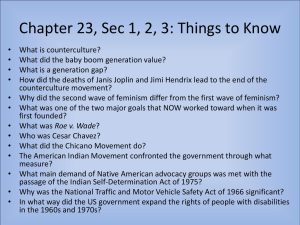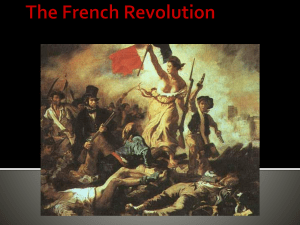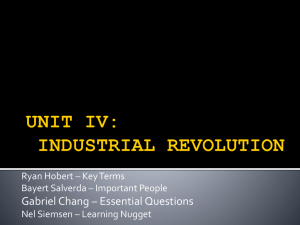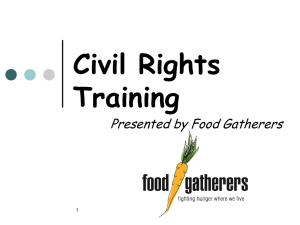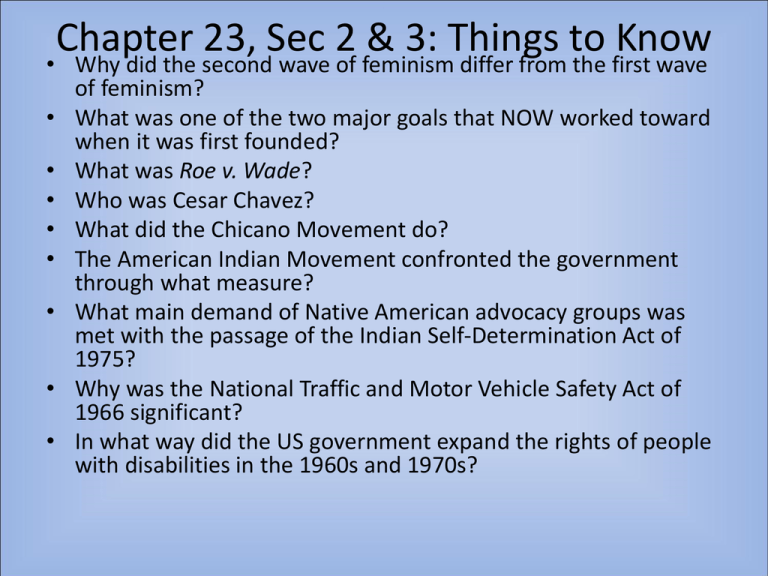
Chapter 23, Sec 2 & 3: Things to Know
• Why did the second wave of feminism differ from the first wave
of feminism?
• What was one of the two major goals that NOW worked toward
when it was first founded?
• What was Roe v. Wade?
• Who was Cesar Chavez?
• What did the Chicano Movement do?
• The American Indian Movement confronted the government
through what measure?
• What main demand of Native American advocacy groups was
met with the passage of the Indian Self-Determination Act of
1975?
• Why was the National Traffic and Motor Vehicle Safety Act of
1966 significant?
• In what way did the US government expand the rights of people
with disabilities in the 1960s and 1970s?
Chapter 23: An Era of Protest and
Change
Section 2: The Women’s Rights
Movement
• Historians often refer to the women’s movement of
the 1960s and 1970s as the second wave of
feminism, or the theory of political, social, and
economic equality of men and women.
– Why did the second wave of feminism differ from the first
wave of feminism?
• Because modern women wanted full equality with men, not just
the right to vote.
– The civil rights movement both inspired women to
demand gender equality and taught them ways to get it. It
also brought black and white women together,
strengthening their shared cause.
The Women’s Rights Movement
• Several years after she wrote The Feminine Mystique,
Betty Friedan helped establish the National
Organization for Women (NOW).
– NOW set out to break down the barriers of discrimination
in the workplace and in education.
– Its first goal was to bring about the passage of the Equal
Rights Amendment.
– What was one of the two major goals that NOW worked
toward when it was first founded?
• Protecting reproductive freedom. They wanted the right of a
woman to make the decision of having an abortion. The other
goal was to get the ERA passed.
The Women’s Rights Movement
• The NOW organization was considered by some to be
too tame.
– These people believed in a more radical approach to fight
for women's rights.
– Not everyone was for the women’s rights movement.
Some actually opposed the women’s rights movement.
• Phyllis Schlafly was a conservative political activist who denounced
women’s liberation as a “total assault on the family, on marriage,
and on children.” With her help, the ERA fell three states short of
becoming a constitutional amendment.
The Women’s Rights Movement
• The women’s movement did have lasting effects even
though it faced several setbacks. Women gained legal
rights that had been previously denied.
– Several laws and bills were passed helping women:
• The Civil Rights Act of 1964 gave feminists a legal tool. It included
a clause called Title VII that outlawed discrimination on the basis
of sex.
• The Equal Employment Opportunity Commission (EEOC) was set
up to enforce the federal prohibition on job discrimination.
• Title IX of the Higher Education Act of 1972 banned discrimination
in education.
• The Equal Credit Opportunity Act in 1974 made it illegal to deny
credit to a woman just because of her gender.
The Women’s Rights Movement
• Some feminists considered their most important
legal victory to be in the 1973 Supreme Court
decision of Roe v. Wade.
– What was Roe v. Wade?
• The 1973 Supreme Court case on abortion. It assured women the
right to legal abortions. The case and its decision was highly
controversial at the time and still is today.
– The workplace was the last thing to change for women.
• The percentage of women in the workplace rose from 30 percent
in 1950 to more than 60 percent in 2000.
The Women’s Rights Movement
• Despite these gains, the average woman still earns less
than the average man, partly because many women
continue to work in the jobs that pay less.
– Some have referred to this situation as a “pink collar ghetto.”
• Whether this is because of discrimination, or because women who
shoulder family responsibilities often have limited job choice,
remains a matter of debate.
• Some believed that there was a glass ceiling over the heads of
women, allowing them to only reach certain heights in the
workplace.
• These situations have caused a feminization of poverty, making the
working woman get the lowest paying jobs with the fewest
benefits. Many of these poor women are single mothers.
Section 3: The Rights Revolution
Expands
• The next expansion of the civil rights movement was
for minority groups. These groups still faced
discrimination and poverty across the nation.
– The Latino population was growing throughout the nation.
– Mexican Americans, known as Chicanos, have always made
up the largest group of US Latinos.
– Chicanos had been coming to America in high numbers
since the bracero programs in 1942. They settled in
communities across the nation where they faced severe
discrimination.
The Rights Revolution Expands
• Who was Cesar Chavez?
– He was the Latino union leader. He fought for the rights for
farm laborers, who were among the most exploited workers in
the nation. These workers were known as migrant farmworkers.
• They labored for long hours in deplorable conditions, with no
benefits.
– Chavez merged his union with the United Farm Workers (UFW)
union which was for Filipino farm laborers.
• They were committed to nonviolent tactics and implemented a
workers’ strike and consumer boycott of table grapes.
• In 1975, California passed a law requiring collective bargaining
between growers and union representatives. The farmworkers
won their battle for rights.
The Rights Revolution Expands
• While Chavez focused on farmworkers’ rights, a broader
Mexican American social and political effort grew, which
came to be known as the Chicano Movement.
– What did the Chicano Movement do?
• It increased Latinos’ awareness of their history and culture.
– Chicano students at high schools and universities demanded
educators to teach more about their culture and heritage.
– Much of the movement’s energy was focused on attaining
political strength for Latinos, what some called “brown power.”
– The party worked for better housing and jobs, and it successfully
brought six Hispanics to sit in Congress.
The Rights Revolution Expands
• Native Americans suffered a long history of
discrimination and suffered high poverty, unemployment,
and suicide.
– In 1961, the National Indian Youth Council (NIYC) formed, with
the goal of preserving native fishing rights in the Northwest.
– They expanded their aims to broad civil rights for Native
Americans and in 1968 founded the American Indian Movement
(AIM).
– AIM focused first on helping Indians living in urban ghettos but
later moved to addressing all civil rights issues, particularly to
secure land, legal rights, and self-government for Native
Americans.
The Rights Revolution Expands
• In the 1960’s a group of Native American Indians
occupied Alcatraz Island, a former prison in San
Francisco Bay which had closed in 1963.
– Members of the Sioux tribe claimed it was their land under
a treaty provision granting them unused federal land.
– About 100 American Indians representing 50 tribes joined
the occupation.
• Despite efforts of the Coast Guard to evict them, they remained in
control of the island until mid-1971.
The Rights Revolution Expands
• The 1970s saw another series of confrontations.
– The American Indian Movement confronted the
government through what measure?
• A march from San Francisco to Washington, D.C. The event was
called the “long march,” which happened in 1972.
• Upon arriving at the capital, they took control of the Bureau of
Indian Affairs building. They temporarily renamed it the Native
American Embassy, suggesting Native Americans are treated as
foreigners.
• The government would take back the Bureau when the Indians left
after a week of protesting. Before they left, they caused nearly
$700,000 worth of damages.
The Rights Revolution Expands
• AIM would later stage a dramatic confrontation at the historic site of
Wounded Knee. This came about due to the awareness that was raised
about the treatment of Native Americans in a book about the event.
– In late February of 1973, AIM took over the village and refused to leave
until the government agreed to investigate the conditions of reservation
Indians.
• Federal authorities put Wounded Knee under siege; two Native Americans
were killed in the resulting gunfire. The event ended in May after the
government pledged to reexamine native treaty rights.
– Later, the Indian Self-Determination Act of 1975 would be passed.
– What main demand of Native American advocacy groups was met with the
passage of the Indian Self-Determination Act of 1975?
• It granted tribes greater control over resources on reservations.
The Rights Revolution Expands
• In the same way that many activists worked to extend peoples’ rights
and to protect the environment, others worked to protect the rights of
consumers and Americans with disabilities.
– Ralph Nader led the reemergence of the consumer rights movement
in the 1960s and 1970s.
• Nader was a lawyer who began to investigate whether flawed car designs
led to increased traffic accidents and deaths.
• He wrote a book that sparked Congress to pass the National Traffic and
Motor Vehicle Safety Act in 1966.
• Why was the National Traffic and Motor Vehicle Safety Act of 1966
significant?
– It recognized the right of consumers to buy safe cars.
The Rights Revolution Expands
• Historically, the nation had treated people with
disabilities as being defective.
– By the 1970s, people with disabilities were making great strides
toward expanding their rights.
– Disabled veterans also took part in this activism.
– The JFK administration called for change by establishing the
Panel on Mental Retardation in 1961 to explore ways for the
government to help people with intellectual disabilities.
– Eunice Shriver, Kennedy’s sister, started the Special Olympics.
– In what way did the US government expand the rights of people
with disabilities in the 1960s and 1970s?
• Congress passed laws guaranteeing them access to education.
In Conclusion…
• The counterculture that came around in the 1960s and 1970s
was considered a defiance to all things that the baby boomers
had obeyed in previous years. It ended with the conclusion that
drugs were actually deadly.
• Women’s rights were something that had been a long time
coming. The second wave of feminism would fundamentally
change Americans life – from family and education to careers
and political issues.
• Minority groups and the disabled experienced discrimination
just as women did during this era. Activists worked to expand
rights for two broad groups: consumers and people with
disabilities. Their success, again, was limited, but would create a
stepping stone for future presidents and legislation.

